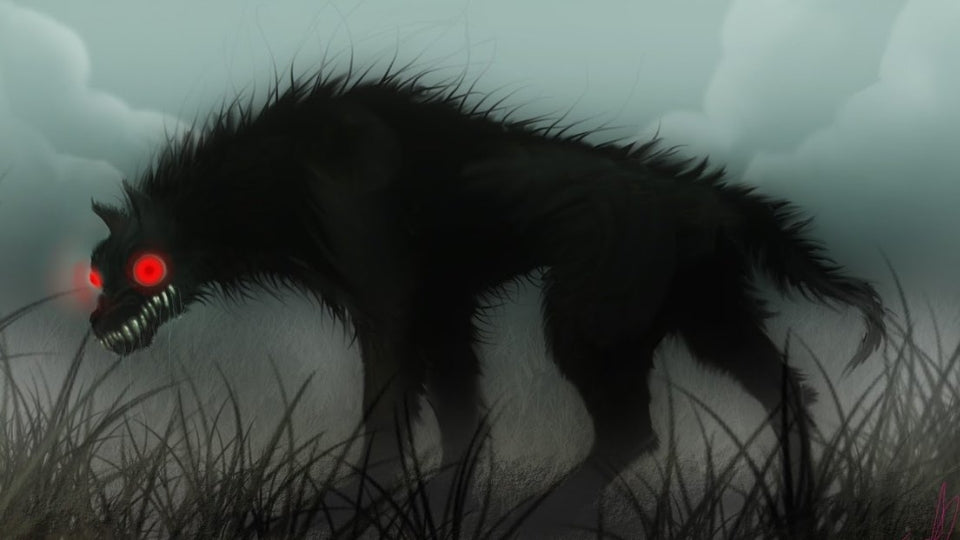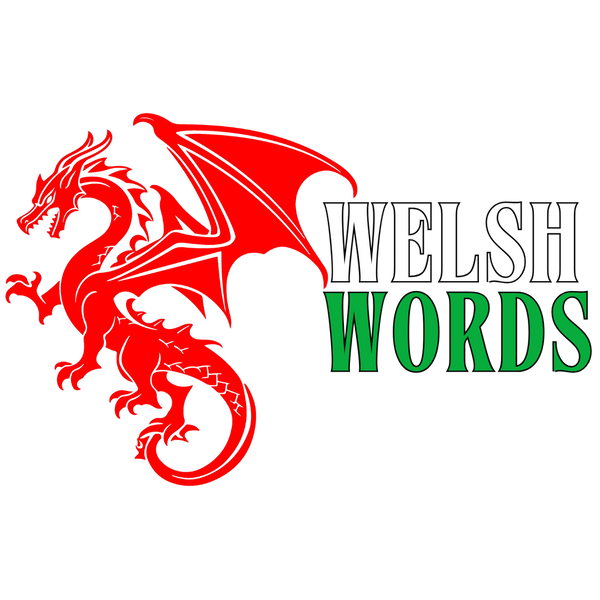
Dog of Darkness - Gwyllgi
Gwyllgi (pronounced gwill-gee) is the Welsh word for a spectral black dog, a supernatural being that roams the darkness, and is part of Welsh folklore. This spectral hound, also known as the ‘Dog of Darkness’ or ‘Dog of the Twilight’, is a creature of nightmares that often strikes terror into the hearts of whoever confronts it. Like its counterparts in other cultures – the English Black Shuck, Manx Moddey Dhoo or the Irish Cú Sídhe and Scottish Cù-Sìth– the gwyllgi is a harbinger of death or disaster, sometimes seen in lonely places at night. Its plural is gwyllgŵn.

The gwyllgi is a fearsome creature with glowing red eyes and a huge, menacing, shadowy form. It is both a representation of the fear of the darkness and of the ancient belief in the watchful, punishing and protective power of spirit-animals.
Gwyllgi is a compound word, consisting of Gwyll – Welsh for gloam, dusk or simply twilight. The second element, ci, is Welsh for ‘dog’. The second element in a compound word in Welsh is frequently soft-mutated when the two words are combined. The soft mutation of ci to gi is triggered because it's part of a compound word, and this is a regular feature in Welsh. In compound words, the first word stays in its base form, while the second typically mutates, regardless of gender or whether it's a noun or another part of speech.
Mutations
Soft Mutation: Ei wyllgi (his black dog)
Nasal Mutation: Fy nghwyllgi (my black dog)
Aspirate Mutation: Remains unchanged as ‘g’ is not affected by this mutation
Origins and Meaning
The legend of the gwyllgi, in turn, stretches back a millennium or more to a Celtic tradition that often connected dogs to the realm of the dead, and saw them as guides to otherworldly places, able to travel between the living and the departed. The gwyllgi is a ghostly being, Death’s emissary and the forces of the unnatural world that exist on the edges of human society.
Some medieval Welsh rural communities still thought that seeing a gwyllgi was a portent of death or misfortune: it was said to appear on dark roads, or in lonely places, at dusk or in the darkest hours of the night. The hound was sometimes described in the context of the hunt, as a dark force pursuing lost souls or leading them to the other side.
Contrary to its sinister image, the gwyllgi also had a protective side. In some tales, the hound would warn travellers of approaching danger or protect places from dark spirits. Yet its appearance was never welcomed – its presence indicated that the domain of death and the supernatural was never far away.
The Appearance of the Gwyllgi
It’s usually described as a large, coal-black dog with a thick, shaggy coat and either red eyes that burn bright or else eyes that glow. It is often likened to a mastiff or large wolfhound, and its description seems to suggest a muscular body, big enough to strike fear in the heart of any human. The part of its appearance that looks to be the most frightening is its stare: if you’re one of the few who are lucky enough (or unlucky enough) to see the red eyes of a gwyllgi glaring at you in the dark, then you’ll know that you are in the presence of something that doesn’t belong in our world.

Although it is mostly silent, it is also said to emit a dreadful howl, its plaintive cry echoing across the landscape. Some folklore suggests that the gwyllgi howls to signal the death of an individual nearby, while other tales portray it as a desperate attempt to communicate with the people of Earth.
Gwyllgi in Welsh Folklore
The gwyllgi features in several folktales from various parts of Wales: it was accounted for in regional lore and believed to be attached to certain places. One of the most famous gwyllgi tales is from Denbighshire. Here, the gwyllgi was said to be active in the area around Nant y Garth Pass, a thin, lonely lane. People would talk about a huge black dog that would pursue travellers at night, suddenly disappearing, like a phantom. Though many didn’t believe in the supernatural, such tales were well-known around the area, and people would avoid the lane after dark for fear of the spectral hound.
Another gwyllgi legend comes from Ceredigion, here described as a black dog patrolling the cliffs at night as it watches over the coast: In this area, the myth of the gwyllgi is more about protecting sailors or fishermen, warning them of dangerous conditions and helping them stay safe. The gwyllgi was still frightening, but more in keeping with the Irish tradition of dogs as guardians.
The Gwyllgi and the Cŵn Annwn
It was also sometimes associated with the Cŵn Annwn (Hounds of Annwn), the spectral hounds of Arawn, the king of Annwn (or Otherworld), who were said to chase after the souls of the dead or those who had committed crimes, dodging their every step as they ran across the land. In some versions of the legend, the gwyllgi is a lone member of this pack, left behind to hunt in the mortal world.

Modern Reflections of Gwyllgi
While the beliefs in the gwyllgi have largely disappeared with the disappearance of rural superstitions, the legend of the spectral black dog persists in contemporary Welsh culture. Ghost tours and storytelling nights in Wales commonly report ghost sightings of black dogs or strange encounters with the gwyllgi on foggy nights. The ‘dark landscape + spectral hound’ equation still resonates with people, especially in rural areas where traditional lore forms part of local heritage.
The Gwyllgi in Popular Culture
The legend of the gwyllgi has been appropriated in a few television series and films based in Wales. The crime series Y Gwyll/Hinterland (2013) is set in rural mid-Wales and often seems to convey the dark, brooding presence of the gwyllgi, mute spectre and omnipresent force, watching and waiting. In these series and similar ones, such as the BBC’s dark thriller Keeping Faith (2017), the supernatural is often only implied, not explicitly narrated. Yet the folklore of the black dog and its dark role as a precursor of death is compelling as a metaphor.
The gwyllgi also appears in the Fire Emblem - a Japanese fantasy tactical role-playing game franchise.
“Ferocious, three-headed hellhounds. Their triple-fanged bites are difficult to dodge.”
- In-game description in The Sacred Stones
The gwyllgi is still very much alive, its presence a dark force to be feared and admired, whether it be a signifier of death, a supernatural messenger or a guardian of lonely places. Although the black dog’s legend has passed largely into the realm of storytelling, it remains a reminder of the truth, hidden in plain sight, that Wales’ landscapes and its supernatural forms have always been entwined.

Test Your Knowledge: Gwyllgi Quiz 🐕🦺
Thanks for reading! How well did you pay attention? Answer these questions about the Gwyllgi and its place in Welsh folklore in the comments below. Share your thoughts or any experiences with similar legends!
1. What is the meaning of the word "Gwyllgi"?- A) Dog of Darkness/Dog of Twilight
- B) Fire Dog
- C) Night Wolf
- D) Black Shuck
- A) Good fortune
- B) A death or disaster
- C) A change in the weather
- D) A bad dream
- A) Denbighshire
- B) Powys
- C) Ceredigion
- D) Gwent
- A) White fur
- B) Glowing red eyes
- C) Horns
- D) A missing leg
- A) As a character in a video game
- B) As a symbol of Welsh royalty
- C) In modern advertising campaigns
- D) As a popular comic book hero
Enjoy testing your knowledge and exploring this mysterious Welsh legend!


